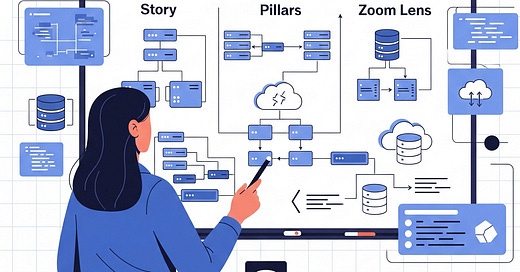Hi Friends,
System Design interviews can feel like solving a Rubik’s Cube while blindfolded. 😵💫 You’re expected to design scalable, fault-tolerant, efficient systems — often in under an hour. But what if you had mental shortcuts that cut through the noise?
Today, I’ll share 3 powerful mental models that can help you simplify, structure, and actually enjoy your system design interviews.
Let’s ditch surface-level tips and go deep. 🔍
⚙️ 1. The “Narrator” Model
Think like a storyteller, not an architect.
Before you even mention a load balancer or a cache, ask:
👉 “What story is this system telling?”
Is it about speed, scale, reliability, or cost-efficiency? Every system design question has a hero (the user), a conflict (the scale, latency, or failure problem), and a resolution (your design).
Use this model to:
Clarify why the system exists.
Tailor your design to the business context.
Stay grounded in purpose over parts.
🧠 Inspired by: “Made to Stick” by Chip Heath — clarity beats complexity.
🏗️ 2. The “Pillars & Planks” Model
Build in layers — start with pillars, add planks.
This framework forces you to zoom out first, then zoom in.
Pillars: Core components like frontend, backend, DB, caching, messaging.
Planks: Specific design decisions (e.g., Redis vs Memcached, S3 vs local FS).
Why it works:
It prevents “tech thrashing” — jumping to tools too early. You won’t fumble trying to remember what database is best. You’ll build a structurally sound base first.
📖 Referenced in: “The Systems Design Interview” by Alex Xu — but with a narrative-first twist.
🌍 3. The “Zoom Lens” Model
Always move between macro and micro.
Imagine you’re holding a zoom lens:
At wide-angle, you’re thinking about end-to-end data flow and traffic.
At telephoto, you focus on bottlenecks: disk I/O, cache invalidation, race conditions.
This back-and-forth builds your credibility. You’re not just a dreamer — you’re also a debugger.
💡 Pro Tip: Use phrases like “at the high level” and “drilling down” to signal these shifts. It makes you sound composed and structured.
📘 From: “Designing Data-Intensive Applications” by Martin Kleppmann — a must-read for real-world system thinking.
💼 Try the S.E.E. Framework:
Story — start with the “why”
Essentials — identify the 3–5 pillars
Evaluate — zoom in, justify trade-offs
This simple 3-part framework has helped over 500+ devs simplify their system design prep and walk into interviews feeling like pros.
💬 Got Questions?
Reply to this email — I personally answer all system design-related queries. Or if you're deep in prep mode, try our AI-powered interview coach.
🚀 AceInterviewAI is now LIVE — your personal AI coach with a brand-new Live Coding Mock Mode to simulate real interviews.
Try it free → AceInterviewAI.com
📲 Stay Sharp, Stay Ahead
📺 Subscribe on YouTube for interview breakdowns
📚 Save this newsletter — you’ll want it before your next big interview
"You don’t rise to the level of your goals. You fall to the level of your systems."
— James Clear, Atomic Habits
Until Next time,
Jenifer




